Woolwich
| Woolwich | |
 Beresford Square market with Royal Arsenal gatehouse (left) and Crossrail development in the background |
|
 Woolwich |
|
| Population | 71,526 (Woolwich Common, Woolwich Riverside, Plumstead and Glyndon wards 2011) |
|---|---|
| OS grid reference | TQ435795 |
| – Charing Cross | 8.5 mi (13.7 km) WNW |
| London borough | Greenwich |
| Ceremonial county | Greater London |
| Region | London |
| Country | England |
| Sovereign state | United Kingdom |
| Post town | LONDON |
| Postcode district | SE18 |
| Dialling code | 020 |
| Police | Metropolitan |
| Fire | London |
| Ambulance | London |
| EU Parliament | London |
| UK Parliament | Greenwich and Woolwich |
| London Assembly | Greenwich and Lewisham |
Coordinates: 51°29′17″N 0°03′47″E / 51.488°N 0.063°E
Woolwich (/ˈwʊlɪtʃ/ or /ˈwʊlɪdʒ/ WOUL-ich) is a town in the Royal Borough of Greenwich, south east London, England, which became part of the London metropolitan area in the mid 19th century, although remaining part of Kent until 1889. In 1965, most of the Metropolitan Borough of Woolwich became part of Greenwich Borough, of which it is the administrative centre.
Throughout the 18th, 19th and most of the 20th century, Woolwich was an important military and industrial town. It is a river crossing point, with the Woolwich Ferry and the Woolwich foot tunnel crossing to North Woolwich. Woolwich is identified in the London Plan as an "opportunity area" as well as one of 35 major centres in Greater London, with a potential to become a metropolitan centre.[1]
History
Toponymy and early history
Woolwich has been inhabited since at least the Iron Age. Remains of a probably Celtic oppidum, in the late Roman period re-used as a fort, were found at the current Waterfront development site between Beresford Street and the Thames.[2]
It is generally believed that the name Woolwich derives from an Anglo-Saxon word meaning "trading place for wool". It is not clear whether Woolwich was a proper -wich town, since there are no traces of extensive artisanal activity from the Early Middle Ages. However, in 2015 Oxford Archaeology discovered a Saxon burial site near the riverside with 76 skeletons from the late 7th or early 8th century. The absence of grave deposits indicates that this was an early Christian settlement.[3]
From the 10th till the 12th century Woolwich was ruled by the abbots of St. Peter's Abbey in Ghent, probably as a result of a gift from Ælfthryth, daughter of King Alfred and Countess of Flanders. In 1236 many were killed by a flood. Woolwich Ferry was first mentioned in 1308.[4]
Urban development
Woolwich remained a small Kentish village until the beginning of the 16th century, when it began to develop into a maritime, military and industrial centre. It was first home to Woolwich Dockyard (founded in 1512 by Henry VIII), followed by the Royal Arsenal (dating back to 1671), then by other military establishments such as the Royal Artillery (1716) and the Royal Military Academy (1741). In the 19th and 20th century several large barracks were built, as well as military schools and hospitals. To this day the town still retains an army base at the Royal Artillery Barracks and Napier Lines Barracks.

Woolwich Dockyard, where many great ships were built, such as the Henry Grace à Dieu, the Prince Royal, the Sovereign of the Seas, the Royal Charles, the Dolphin and the Beagle, closed in 1869. The Royal Arsenal, originally known as The Warren, gradually developed from a place of storage into a giant military factory. Especially at wartime, tens of thousands of factory workers found employment here. Between wars, unemployment loomed.
In 1868 the Royal Arsenal Co-operative Society was established, which developed into one of the biggest consumer cooperatives in the country with two department stores in Powis Street, shops around South East London, manufacturing and food production plants, a building society, a funeral service and many other areas of entrepreneurship.
Arsenal F.C. were founded here in 1886 by workers at the Arsenal. Initially known as Dial Square, then Royal Arsenal and then Woolwich Arsenal, they moved to Arsenal Stadium, Highbury in North London in 1913. Royal Ordnance Factories F.C. was founded in response to Woolwich Arsenal joining the League but only lasted several years.
Woolwich Polytechnic, another great Woolwich establishment, was founded in 1892. It merged with other local colleges and became Thames Polytechnic in 1970. In 1992 it was granted university status as the University of Greenwich. In 2000, the University relocated to the Old Royal Naval College, several miles to the west in Greenwich town centre, leaving only a small administrative presence in Woolwich.

Woolwich was on the route of two London trams of the first generation (c. 1880-1952).[5] The town once had four cinemas. The former Granada cinema, as well as the former Odeon, later Coronet, both seating around 2,500, are now Pentecostal churches. The Century cinema, which faced Beresford Square, was demolished for redevelopment in the late 1960s.
Woolwich was home to the experimental Auto Stacker car park. Built on the site of the Empire Theatre, it was officially opened in May 1961 by Princess Margaret. It was never actually used by the public and was demolished in 1962, after the council could not get it to work.
Woolwich is also the location of the United Kingdom's first branch of McDonald's, which opened on 13 November 1974.[6] Woolwich was selected because it was considered to be a representative English town at the time.[7]
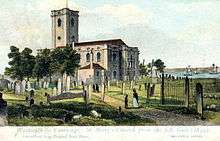
Local government
Woolwich, formerly known as the parish of Woolwich Saint Mary, became part of the London metropolitan area in the mid 19th century, although officially still in Kent. Up till 1842, before the Old Town Hall was built, the vestry met in a room in the parish church of St Mary Magdalen. In 1889, with the formation of London County Council, Woolwich became officially part of London. In 1900 the parishes of Woolwich, Eltham and Plumstead formed the Metropolitan Borough of Woolwich. In 1906 the new Woolwich Town Hall was inaugurated. In April 1965, following implementation of the London Government Act 1963, Woolwich was merged into the London Borough of Greenwich, since 2012 the Royal Borough of Greenwich. The administrative buildings of the borough are all in Woolwich.
Decline
Woolwich declined as a town in the late 20th century, starting with the closure of the Royal Ordnance Factory in 1967 and the Siemens factory in 1968 and continuing as the Royal Arsenal scaled back operations and finally closed in 1994. Without major employers, the local economy was affected and the demographics of Woolwich changed. In the town centre, department and chain stores closed and the sprawl of the town centre shrank. By the early 1990s, the town centre had the typical appearance of a town in decline with discount retailers and charity shops using the empty stores. Some properties were used by Greenwich council as offices. In general, Woolwich had lost most of its previous vigour.
In 1974 the Provisional IRA bombed the Kings Arms pub in the town, killing two. During the 2011 England riots Woolwich was one of the areas affected. Several buildings were attacked, with a few being destroyed. The Great Harry Wetherspoons' Pub was set on fire, leaving it a burned-out shell.[8] On 22 May 2013 the Murder of Lee Rigby in Woolwich caused great international upheaval. Drummer Lee Rigby, a British soldier based at the Royal Artillery Barracks, was murdered close to the barracks by two Islamic extremists.[9]
Although the 16th Regiment Royal Artillery left in 2007, Woolwich Barracks still house the Royal Artillery Band and more recently Second Battalion Princess of Wales' Royal Regiment and King's Troop, Royal Horse Artillery.
Regeneration

Woolwich started to enjoy the beginning of a renaissance with the residential redevelopment of the former Royal Arsenal. Most historic buildings on the site have been renovated and converted into apartments. Additionally, a riverside walk, several parks, a museum, a range of shops, cafes and gastropubs, and a farmers' market have made the Royal Arsenal a desirable place to live. Several thousands of homes have been built or are under construction and thousands more are planned, mainly luxury apartments in tower blocks near the river.
Woolwich Arsenal DLR station, the terminus of the Docklands Light Railway's London City Airport branch, opened on 10 January 2009.[10] The 2012 Summer Olympics and Paralympics included Woolwich as a venue for shooting events, held in temporary facilities constructed on the grounds of the Royal Artillery Barracks and on Woolwich Common.[11] The arrival of Crossrail in 2018 is expected to further stimulate regeneration, especially in the area close to Woolwich Crossrail station.

A large-scale redevelopment of the area west of General Gordon Square started in 2011. The square was re-landscaped, including a new water feature. The so-called Love Lane project involved demolition of several buildings including the Post Office, the Crown Building, the Director General public house,[12] Peggy Middleton House and Thomas Spencer Halls of Residence. New buildings included the Woolwich Centre along Wellington Street (public library and council offices) and a large housing development above a Tesco hypermarket. The development was largely completed in 2012, except for the southwestern section (along the South Circular Road). On the other side of General Gordon Square the 1930s Woolwich Equitable building was refurbished. Next to Woolwich Town Hall on Wellington Street, the 1950s Woolwich Grand Theatre (formerly the ABC Regal Cinema, then Flamingo's Nightclub) briefly reopened as an arts centre with a cafe but in 2015 the building was demolished to make room for apartments.

Redevelopment around the "Woolwich Triangle" at the west end of Powis Street is partly underway. It originally envisaged demolition of the art deco RACS department store, one of two imposing Co-op buildings in this part of town.[13] In September 2012 Greenwich Council approved a plan to convert the building into apartments and retail.[14] Across the road, the late Victorian former RACS Central Stores building was renovated and re-opened as a hotel. Further regeneration is centred on Hare Street and the Riverside. By relocating the Waterfront Leisure Centre, it is hoped that this part of Woolwich will attract new development. Other areas for redevelopment include Trinity Walk (former Connaught Estate, part of the One Woolwich masterplan for three housing estates), several sites along Wellington Street (including the Ogilby site and the so-called Island site), the Spray Street Quarter (between the existing station and the new Crossrail station), and the Callis Yard site (former council stables).[15]
Population
Below is a table comparing Woolwich and the wider borough of Greenwich:[16]
| Woolwich compared 2011 | White British | Asian | Black |
|---|---|---|---|
| Woolwich Population 71,526 | 36.1% | 20% | 27.1% |
| London Borough of Greenwich | 52.3% | 11.7% | 19.1% |
Geography
The nearest areas are Abbey Wood, Blackheath, Charlton, Chislehurst, Eltham, Greenwich, Kidbrooke, Lewisham, Plumstead, Thamesmead and Welling.
Transport
Buses
Woolwich is served by London Buses routes 51, 53, 54, 96, 99, 122, 161, 177, 178, 180, 244, 291, 380, 386, 422, 469, 472 and N1.
Docklands Light Railway
The nearest station is Woolwich Arsenal for Docklands Light Railway services towards Bank, Stratford International and Tower Gateway.
National Rail
The nearest stations are Woolwich Arsenal and Woolwich Dockyard for Southeastern services towards Barnehurst, Dartford, Gravesend, London Cannon Street and London Charing Cross.
London River Services
London River Services, operated by Thames Clipper, provide a peak hour, seven days a week service to central London (Savoy Pier) from Woolwich Arsenal Pier (adjacent to the Royal Arsenal residential development). The Thames flood barrier is located 1 mile (1.6 km) upstream from the tunnel and ferry.
Woolwich Ferry
The free Woolwich Ferry service operates across the River Thames to North Woolwich in the London Borough of Newham carrying trucks, cars, cyclists and pedestrians during the day until 8pm on Weekdays. A two boat service runs on Mondays to Saturdays and Sundays only has a one boat service. Woolwich foot tunnel is also available for use by pedestrians (and cyclists pushing their cycles) at any time. It is served by lifts during traditional shopping hours.
Crossrail
An additional railway station is scheduled to open in 2018 for Crossrail services towards Abbey Wood and Heathrow Airport. This will provide the area with faster, more frequent and more direct rail services.
Culture

The University of Greenwich's dramatic arts department is based in the historic Bathway Quarter in the centre of Woolwich. The old Grand Theatre, which briefly reopened in the 2010s, closed in 2015. The Tramshed, until 1953 an electricity sub-station for the borough's tramways, is a music and entertainment venue run by the Royal Borough of Greenwich.[17] Woolwich currently has no movie theatres. Cinemas are included in the plans for Spray Street quarter and the Island site.[18][19] The town was used as a location for the 2006 film Children of Men.
Woolwich has one museum, the Greenwich Heritage Centre at the Royal Arsenal (Firepower – The Royal Artillery Museum closed in 2016 after having been based in Woolwich for almost two centuries). Second Floor Studios in the Woolwich Dockyard area is one of London's largest concentrations of artists' studios.[20] The town has a number of public sculptures: one of Roman origin, several statues and reliefs from the 19th and early 20th century, and a number of modern sculptures. One of the Woolwich Arsenal station entrances features a large mural in tiles by Michael Craig Martin.
Heritage
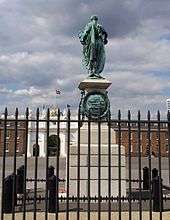
For centuries the area between the Thames and the current town centre has been dominated by docks, warehouses and factories. The Royal Dockyard established here by King Henry VIII in the sixteenth century was the catalyst for Woolwich's eventual development into a military garrison town. Its gun wharf was expanded by the Board of Ordnance in the seventeenth century into what became the Royal Arsenal, a substantial weapons manufactory. Early in the eighteenth century the Royal Regiment of Artillery and the Corps of Royal Engineers were established in Woolwich by the Board of Ordnance, both being headquartered in the Arsenal. A Military Academy was set up there to educate prospective officers of these 'scientific' corps. By the nineteenth century the Royal Artillery had moved out of the Arsenal to new barracks on the Common, to be followed soon by the Royal Military Academy.
Woolwich Dockyard and Royal Arsenal
At Woolwich Dockyard relatively little of historic interest remains. The main monumental building complex comprises a group of 18th-century buildings: the entrance gate, the guardhouse and the so-called Clock House (Dockyard offices). A pair of nineteenth-century docks remain, on the site of their sixteenth-century predecessors, and the later development of the Dockyard in the early Victorian period is represented in a group of buildings alongside the dockyard chimney, a prominent landmark on Woolwich Church Street.
At the Royal Arsenal most buildings of historic interest have been restored and given new uses. The Royal Brass Foundry (1717) is a grade I listed building, while the Dial Arch (1717-20), the Old Royal Military Academy (1720) and the Grand Store (1806-13) are Grade II* listed. Other listed buildings include the Royal Arsenal Gatehouse, Middle Gatehouse, the Main Guard House, two small guardhouses near the Thames, the Shell Foundry Gatehouse, Verbruggen House and two buildings in Laboratory Square, the oldest structures on the site (1696).
Between the Arsenal and the Dockyard lies an area that was once Old Woolwich but is now being redevelopped. The only building of historical interest is the round entrance building of the 1912 Woolwich foot tunnel. Further west, the Thames Barrier is an interesting example of modern architecture and technical achievement. The Thames Path is a National Trail that connects these sights.
 Woolwich Dockyard entrance gate
Woolwich Dockyard entrance gate The Dockyard chimney
The Dockyard chimney Royal Arsenal Gatehouse
Royal Arsenal Gatehouse Royal Brass Foundry
Royal Brass Foundry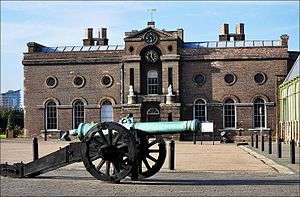 Cannon near the Old Royal Military Academy
Cannon near the Old Royal Military Academy Converted warehouses at the Royal Arsenal
Converted warehouses at the Royal Arsenal Entrance building Woolwich foot tunnel
Entrance building Woolwich foot tunnel.jpg)
Other military buildings
Elsewhere, monumental buildings testify of Woolwich's rich military history. The Neoclassical façade of the Royal Artillery Barracks (James Wyatt, 1776-1802) is the longest façade in London, stretching along the north end of Woolwich Common. Across the road, Government House (1781), was the quarters of the Garrison Commandant from 1855-1995. Of the nearby Garrison Church of St George only the shell remains after it was bombed during the Second World War. Its Neo-Romanesque architecture and remnants of mosaics are still impressive. John Nash's Rotunda, a round brick building with a leaded tent roof, until 2001 housed the Royal Artillery Museum and now serves as a boxing ring for the King's Troop, Royal Horse Artillery in nearby Napier Lines Barracks.
The Royal Military Academy at the south end of Woolwich Common was also designed by James Wyatt and has an almost equally long façade in Mock Tudor style. Other military buildings that survive include Connaught Barracks (built as the Royal Artillery Hospital in 1780), Green Hill Military School and Royal Herbert Hospital on Shooters Hill. The Royal Engineers' HQ was moved to Chatham in 1856, but a small detachment remained in Woolwich, quartered in what is now Engineer House on Mill Hill, just off the Common. Several listed buildings were demolished in the 1970s, including the Grand Depot Barracks of the Royal Military Artificers (1803), Cambridge Barracks (1842, of which the gatehouse still stands) and Red Barracks (1858, only the boundary wall and entrance gate remain). The latter two, on Frances Street, were originally built as barracks and infirmary for the Woolwich Division of the Royal Marines, and each was considered an innovative and influential design. The Marines departed with the closure of the Dockyard, whereupon the buildings were converted into barracks accommodation for various military corps. Rushgrove House (1806) housed the Colonel Commandant of the Marine Barracks (later Cambridge Barracks) from 1855.
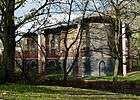 Ruined Garrison Church (1863)
Ruined Garrison Church (1863) John Nash's Rotunda (1814/20)
John Nash's Rotunda (1814/20) Former Connaught Barracks (1780)
Former Connaught Barracks (1780) Engineer House (1858)
Engineer House (1858) Government House (1781)
Government House (1781)- Former Red Barracks gate (1860)
- Gatehouse Cambridge Barracks (1848)
- Rushgrove House (1806)
Woolwich Centre
Nothing is left of the old town of Woolwich which was near the ferry along the Thames. In the early 19th century the town centre moved south to its present location. Although 20th-century economic decline and infrastructural works have had their effects, there are still some interesting buildings in Woolwich town centre. The best preserved area is the Bathway Quarter with the former Public Baths, the Old and New Town Hall, the former Magistrates Court and Police Station, the Old Public Library and several historic buildings of Woolwich Polytechnic.
In nearby Powis Street and Hare Street some late Victorian shop façades have been preserved, notably by local architect Henry Hudson Church. The western end of Powis Street is dominated by two former Royal Arsenal Co-operative Society (RACS) department stores, one late Victorian, the other one in Art Deco style. Nearer to the river are two large cinemas, both built in 1937 and both in use as Pentecostal church halls. The former Odeon Cinema (now occupied by the New Wine Church) is a fine example of an Art Deco theatre; the former Granada Cinema has lavish interior decorations.
Of the grand houses that once stretched along Woolwich Common and dotted the northern slopes of Shooter's Hill, little remains. Rushgrove House, Shrewsbury House and Woodhill Court survive but have lost their spaceous gardens. Woolwich parish church, St Mary Magdalen is a plain brick 1730s building with a spireless tower. Other religious buildings of interest include the Roman Catholic St Peter's Church (by Pugin), and two Sikh gurdwaras, one a former Methodist church, the other a former Masonic hall.

 Former Woolwich Polytechnic College
Former Woolwich Polytechnic College Victorian RACS building
Victorian RACS building- Art deco former RACS department store
 Former Odeon Cinema
Former Odeon Cinema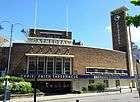 Former Granada Cinema
Former Granada Cinema
- Gurdwara Ramgarhia
Nature
Parks in central Woolwich are generally small. St Mary's Gardens has been laid out as a park in Romantic style on the grounds of the former churchyard of the parish church of St Mary Magdalen. Some historic grave markers have been placed against the peripheral wall. Tom Cribb's memorial, a lioness resting her paw on an urn, stands near the northeast entrance. The park features a belvedere which offers views of the river Thames. At the Royal Arsenal, several new parks and gardens have been landscaped but some can only be accessed by residents.
Shrewsbury Park, Plumstead Common, Woolwich Common and Oxleas Wood are situated higher up the hill and are all part of the South East London Green Chain. Repository Woods is a forested part of Woolwich Common. The area around the lake is a military training ground that is not open to the public. The same applies to Mulgrave Pond and Shooters Hill Golfcourse.
 St Mary's Gardens
St Mary's Gardens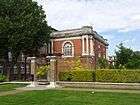 Wellington Park
Wellington Park Dial Arch Square
Dial Arch Square New Riverside Park
New Riverside Park Shrewsbury Park
Shrewsbury Park

- Repository Woods
Sports and leisure
Arsenal F.C. is from Woolwich; Charlton Athletic's stadium, The Valley, is approximately 2km west of Woolwich. The area also has two Non-League football clubs: Bridon Ropes F.C. and Meridian F.C., who both play at Meridian Sports & Social Club.
Greenwich Council has plans to demolish the 1980s Waterfront Leisure Centre next to the Woolwich Ferry and build a new leisure centre in Wilmount Street.
Notable people
- Garry Bushell (born 1955), journalist and political activist, born in Woolwich.
- Tom Cribb, 19th century bare-knuckle boxer, born in Bristol but resided and died aged 66 in Woolwich in 1848, he was buried in St. Mary's cemetery. A road in Woolwich is named after him.
- Charles George Gordon (1833-1885), general, born in Woolwich.
- Joseph Grimaldi (1778-1837), pantomime clown, lived in Woolwich during the early 1830s before moving to Islington.
- Charles Hutton (1737-1823), mathematician, lived and died in Woolwich.
- Richard Lovelace (1618-1657), poet, born in Woolwich.
- Jonathan Guy Lewis (born 1963), actor, born in Woolwich.
- Forbes Macbean FRS (1725-1800), army officer, lived and died in Woolwich.
- Scott Maslen (born 1971), actor and model, born in Woolwich.
- Noizy (born 1986), Albanian musician and actor, lived in Woolwich.
- William Ranwell (1797-1861), artist, lived and died in Woolwich.
- Ray Richardson (born 1964), painter, born and lives in Woolwich.
- John Tapner (c. 1823 – 10 February 1854), last person executed in the island of Guernsey, came from Woolwich.
- Glenn Tilbrook (born 1957), guitarist, born in Woolwich.
- Lesley Vickerage (born 1961), actress, born in Woolwich.
- George Whale (1849–1925), solicitor and bibliophile, Mayor of Woolwich, founded the Samuel Pepys Club In 1903.
- Ian Wright (born 1963), former professional footballer, born in Woolwich.
See also
- List of people from Greenwich
- List of schools in Greenwich
- Royal Ordnance Factory
- Princess Alice – a passenger steamer sunk off North Woolwich pier on 3 September 1878 (a memorial to those lost can be found in Woolwich Old Cemetery, Kings Highway, Plumstead)
References
- ↑ Mayor of London (March 2015). "London Plan (Consolidated with Alterations since 2011), page 374" (PDF). Greater London Authority.
- ↑ Archived 28 March 2010 at the Wayback Machine.
- ↑ M. Litlle: '76 skeletons have been discovered from Saxon Woolwich', southlondonpress.co.uk, 16 October 2015
- ↑ Saint, A., Guillery, P. (ed.), Woolwich - Survey of London, Volume 48, Yale Books, London, 2012, pp. 2-5.
- ↑ BBC on this day: 6 July accessed 23 April 2007
- ↑ Neate, Rupert (18 November 2014). "UK fast-food workers get US lesson in protesting against poverty wages". The Guardian. Retrieved 11 May 2015.
- ↑ Interview with McDonalds UK CEO Evening Standard 16 December 1991 accessed 23 April 2007
- ↑ "Pictures of the destruction on Woolwich streets following a night of violence and looting". Newsshopper.co.uk. 2011-08-09. Retrieved 2012-09-29.
- ↑ "Man dead in suspected Woolwich terror attack". English Heritage list. BBC News Online. Retrieved 22 May 2013.
- ↑ DLR service change from 10 January 2009, accessed 13 January 2009
- ↑ Gilligan, Andrew (2008-08-28). "Olympics minister orders rethink over 2012 plans for Greenwich park - Olympics - Evening Standard". Thisislondon.co.uk. Retrieved 2012-09-29.
- ↑ Fancyapint Ltd (2010-04-06). "Director General public house". Fancyapint.com. Retrieved 2012-09-29.
- ↑ "Coop site redevelopment". Icsouthlondon.icnetwork.co.uk. Retrieved 2012-09-29.
- ↑ http://www.newsshopper.co.uk/news/greenwich/9946365.Former_Woolwich_Co_Op_to_be_converted_into_flats/
- ↑ Woolwich Town Centre Masterplan SPD (April 2012)
- ↑ Woolwich is made up of the Glyndon, Plumstead, Common and Riverside wards http://ukcensusdata.com/greenwich-e09000011#sthash.wkP5XgTF.dpbs
- ↑ History of the Tramshed, Greenwich & Lewisham Young People's Theatre.
- ↑ Spray Street Masterplan, Greenwich Council, January 2015.
- ↑ Second cinema coming to Woolwich as part of new 310-home scheme on fromthemurkydepths.wordpress.com, October 8, 2016
- ↑ Website Second Floor Studios
Further reading
- Daniel Lysons (1792), "Woolwich", Environs of London, 4: Counties of Herts, Essex & Kent, London: T. Cadell
- W.E. Trotter (1849), "Woolwich", Select Illustrated Topography of Thirty Miles Around London, London, OCLC 681272905
- James Thorne (1876), "Woolwich", Handbook to the Environs of London, London: John Murray
- Edward Walford (1883), "Woolwich", Greater London, London: Cassell & Co., OCLC 3009761
- "Woolwich". Chambers's Encyclopaedia. London. 1901.
External links
| Wikimedia Commons has media related to Woolwich. |
| Wikisource has the text of The New Student's Reference Work article Woolwich. |
- Woolwich Royal Borough of Greenwich website
- Hidden London page about Woolwich
- History of Woolwich Ideal Homes: a history of South-East London Suburbs website.
- S.E.18: Impressions of a London Suburb - 1964 film about Woolwich
- History of the Royal Artillery Theatre, Woolwich
- We Love Woolwich
- Digital Public Library of America. Works related to Woolwich, various dates
| Section 15: | Capital Ring Walking Route | Section 1: |
|---|---|---|
| Beckton District Park | Woolwich | Falconwood |





